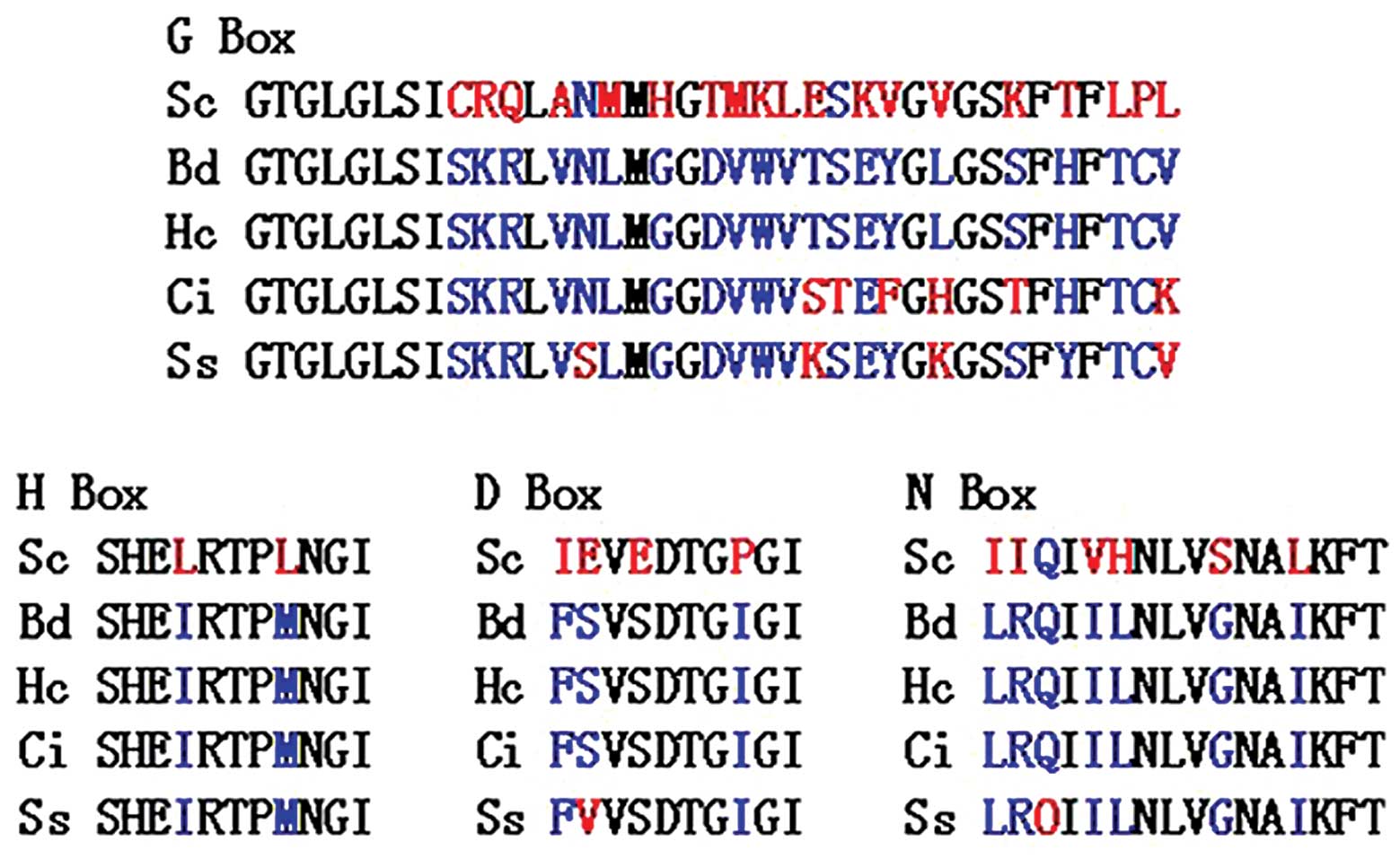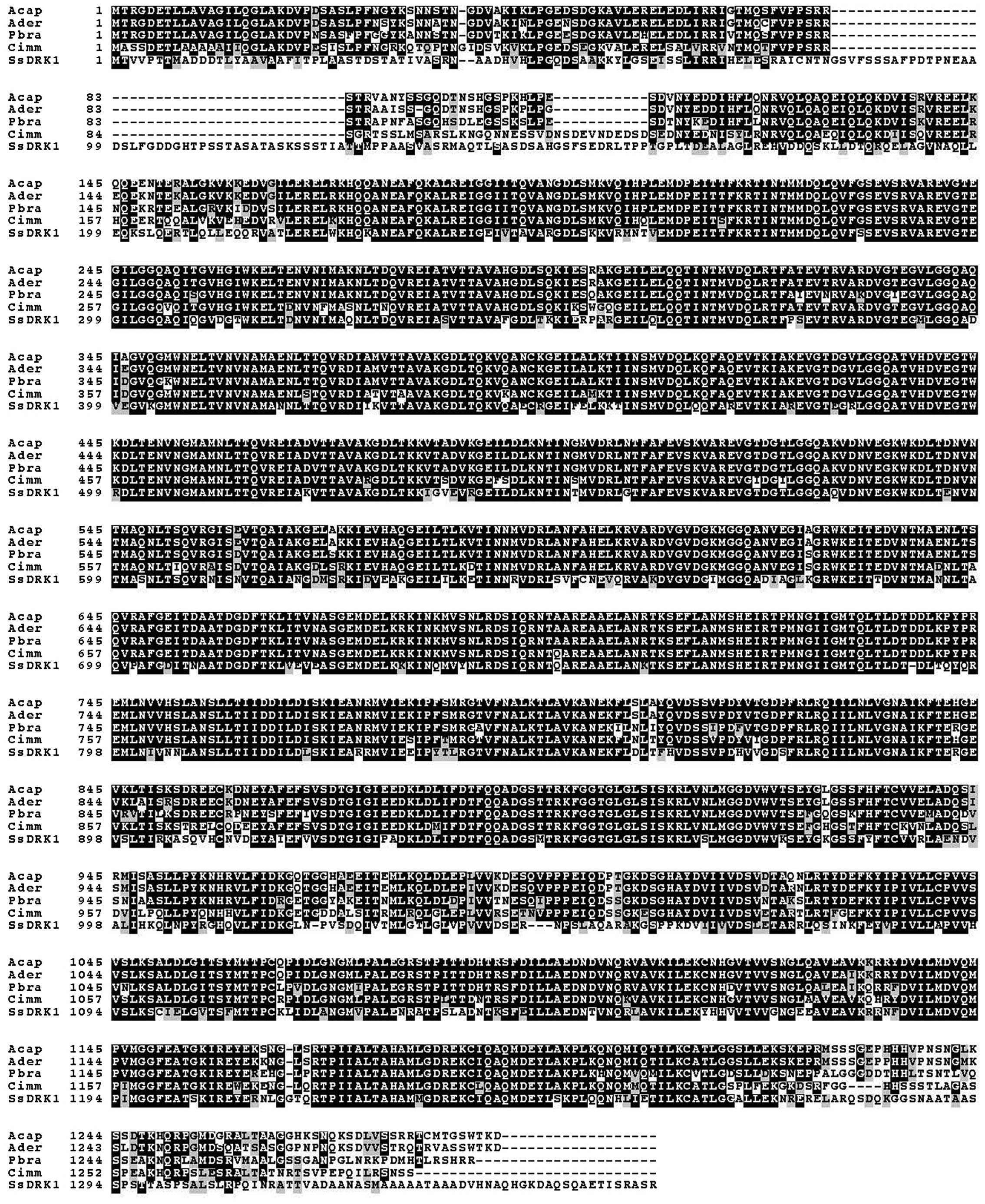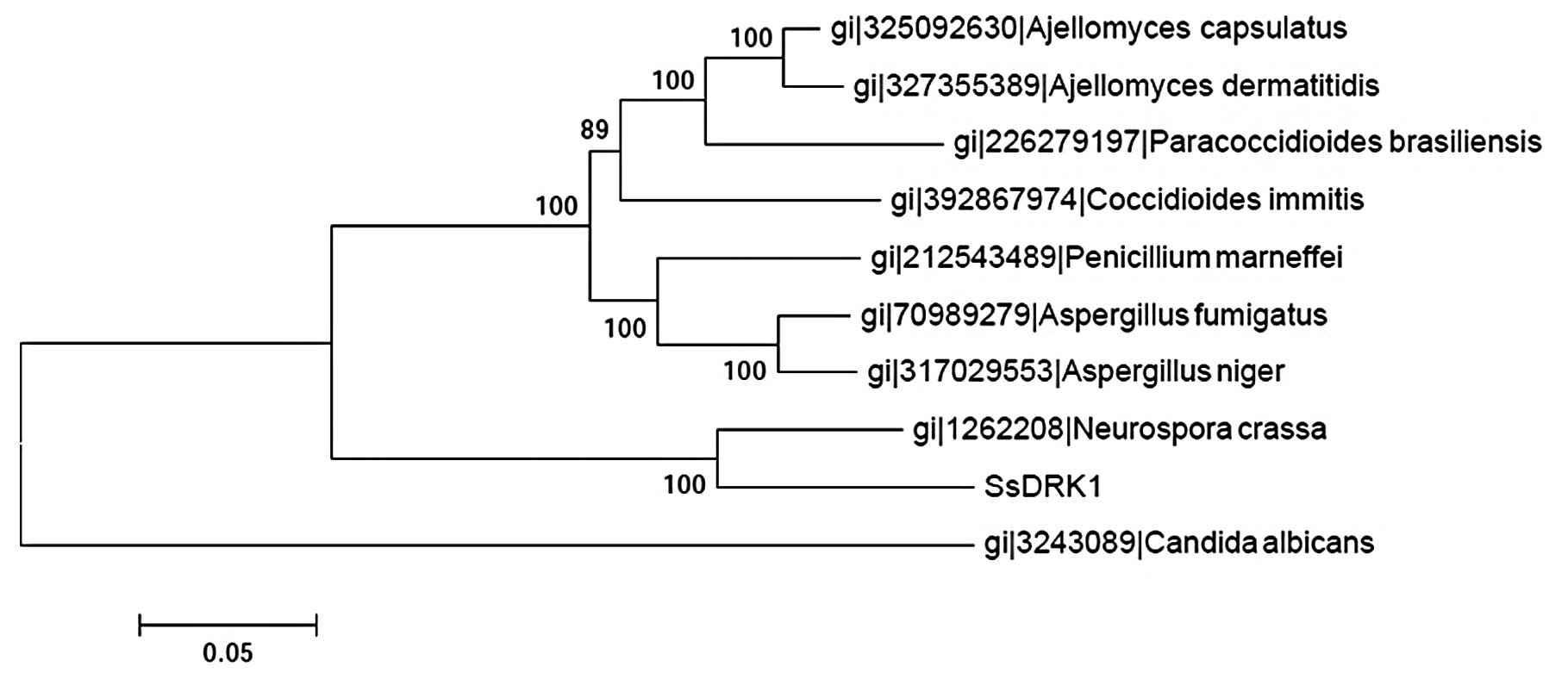Molecular cloning, characterization and differential expression of DRK1 in Sporothrix schenckii
- Authors:
- Published online on: November 22, 2012 https://doi.org/10.3892/ijmm.2012.1193
- Pages: 99-104
Abstract
Introduction
The dimorphic fungus Sporothrix schenckii (S. schenckii) is the etiological agent of sporotrichosis, an important cutaneous mycosis with a worldwide distribution (1). S. schenckii grows at room temperature (25°C) as a mold phase, while in vitro incubation of mold cultures at body temperature (37°C) results in the production of yeast cells (2). These in vitro forms are virtually identical to the yeast cells of S. schenckii found in diseased tissue. Therefore, the formation of yeast cells was thought to be a requisite for the pathogenicity of S. schenckii. The mechanisms that regulate the dimorphic switch, however, remain unclear.
The mitogen-activated protein kinase (MAPK) cascade and cyclic AMP (cAMP) signaling pathways are known to be involved in fungal morphogenesis and pathogenic development. However, the MAPK and cAMP pathways are both activated by an upstream branch, two-component histidine kinase phospho-relay system. Nemecek et al (3) recently uncovered a long-sought regulator that controls the switch from a non-pathogenic mold form to a pathogenic yeast form in dimorphic fungi. They found that DRK1, a hybrid dimorphism-regulating histidine kinase, functions as a global regulator of dimorphism and virulence in Blastomyces dermatitidis (B. dermatitidis) and Histoplasma capsulatum (H. capsulatum). DRK1 is required for phase transition from mold to yeast, expression of virulence genes, and pathogenicity in vivo. Disruption of DRK1 locks B. dermatitidis in the mold form at temperatures (37°C) that normally trigger phase transition to yeast. RNA silencing of DRK1 expression in B. dermatitidis results in impaired BAD1 expression, severe alterations in the cell wall, and reduction in transcription of α-(1,3)-glucan synthase and the yeast-phase specific gene BYS1. In H. capsulatum, DRK1 also regulates expression of the yeast-phase specific genes CBP1, AGS1 and yps-3. We previously reported differentially expressed genes between the mycelial and the yeast phases of S. schenckii using 2DE. The expressed sequence tag of spotC homologous to the DRK1 histidine kinase from B. dermatitidis clearly increases in the yeast form of S. schenckii (4).
We describe the molecular cloning of the DRK1 gene from the yeast-form S. schenckii, designated SsDRK1. We performed necessary function analysis of the SsDRK1 gene as well as detection of the differential gene expression in the dimorphic switch of S. schenckii. These findings establish the primary foundation of understanding the function of SsDRK1. The cloning and characterization of the DRK1 gene in S. schenckii is reported for the first time.
Materials and methods
Fungal strain, media and growth conditions
The strain of S. schenckii used, ATCC10268, was maintained at the Research Center for Pathogenic Fungi, Dalian Medical University, China. To obtain a mycelial culture, the ATCC10268 isolate was inoculated on Sabouraud dextrose agar (SDA) medium and incubated at 25°C. The mycelial colonies thus obtained were inoculated in Sabouraud’s fluid medium and cultured with shaking at 100 rpm at 25°C for 72 h. To achieve the switch of S. schenckii from the mycelial to the yeast phase, mycelial colonies were transferred to brain heart infusion (BHI) liquid medium at 37°C and shaken at 100 rpm for 96 h. Mycelial and yeast pellets were collected by centrifugation and stored at −80°C immediately, or processed for total RNA isolation directly.
Total RNA, genomic DNA isolation and gene cloning
Approximately 100 mg samples of S. schenckii mycelia and yeast were separately pulverized under liquid nitrogen with a mortar and pestle. Total RNA isolation was carried out according to the manufacturer’s protocol using the Trizol Reagent kit (Invitrogen, Carlsbad, CA, USA) and treated with the RNase-free DNase I kit from Takara Bio, Inc. (Tokyo, Japan) to eliminate DNA contamination. Genomic DNA was isolated from yeast phase colonies following the manufacturer’s protocol using the InstaGene™ Matrix kit (Bio-Rad, Hercules, CA, USA). cDNA was synthesized from 500 μg of total RNA of ATCC10268 by murine leukemia virus reverse transcriptase (MLV-RT) (Takara Bio, Inc.) primed with oligo(dT) following the manufacturer’s instructions, and used as template for PCR. Degenerate primers, SsDRK1-F1 and SsDRK1-R1, were designed based on multiple alignments of the high conserved DRK1 domains of Coccidioides immitis (C. immitis) (EAS33695.2), Paracoccidioides brasiliensis (P. brasiliensis) (EEH34763.1), B. dermatitidis (EGE84246.1) and H. capsulatus H88 (EGC45940.1) amino acid sequences. PCR product of expected size was cloned into pMD18 vector (Takara Bio, Inc.) and sequenced. The degenerate primers yielded two fragments, with the length of 161 and 160 bp, respectively. Primers HBB-F and HBB-R were designed to amplify the cDNA sequence between the above two fragments. To obtain the full-length cDNA sequence of the SsDRK1 gene, 5′-RACE and 3′-RACE were performed with 5′-Full RACE kit and 3′-Full RACE Core Set Ver.2.0 kit (Takara Bio, Inc.) according to the manufacturer′s instructions. Nest-PCR was performed. Briefly, five specific primers CTE869-F and CTE869-R of 3′-RACE and R132-1, R132-2 and R132-3 of 5′-RACE were synthesized based on the cDNA sequence obtained by the degenerate primers. PCR products of 5′- and 3′-RACE were both cloned into pMD18 vector (Takara Bio, Inc.) and sequenced.
To determine the nucleotide sequence of the genomic DNA corresponding to the SsDRK1, PCR was performed using the primers SsDRK1-P1 and SsDRK1-B3 and genomic DNA as template. The PCR products were then sequenced. The sequences of all the primers used in this study are listed in Table I.
Bioinformatics and phylogenetic analysis of SsDRK1
Nucleotide sequences and deduced amino acid sequences of the cloned SsDRK1 gene were analyzed. The nucleotide sequences were analyzed using Sequencer software (Sequencer, USA) and BLAST Network service of the National Center for Biotechnology Information (NCBI) (http://www.ncbi.nlm.nih.gov/blast). The open reading frame (ORF) was found by the ORF finder (http://www.ncbi.nlm.nih.gov/gorf/gorf.html). For the exact localization of the exon/intron boundaries the mRNA-to-genomic alignment program Spidey (http://www.ncbi.nlm.nih.gov/IEB/Research/Ostell/Spidey/index.html) was used. The deduced amino acid sequence was analyzed with the Expert Protein Analysis System (http://www.expasy.org/) and the protein domain features of SsDRK1 were determined by using Simple Modular Architecture Research Tool (http://hits.isb-sib.ch/cgi-bin/PFSCAN). Isoelectric point and molecular weight prediction were carried out at (http://cn.expasy.org/tools/pi_tool.html). Multiple alignments of SsDRK1 were performed with the ClustalW Multiple Alignment Program (http://www.ebi.ac.uk/clustalw/).
Differential expression of SsDRK1 in two stages during dimorphic switch
The expression of SsDRK1 transcript in different stages (mycelial, yeast) was measured by real-time RT-PCR. Primers and a TaqMan probe for target genes were designed with primer select in DNASTAR software (Lasergene) and are listed in Table I (24T, 8F, 58R). Fifty nanograms of total RNA were assayed from two stages of S. schenckii in triplicate using the PrimeScript RT-PCR kit (Takara Bio, Inc.). The minus-reverse transcriptase control was also performed in triplicate. The amplification conditions were optimized for the ABI PRISM-7500 instrument (Applied Biosystems). The cycling conditions using TaqMan probe detection were 95°C for 2 min followed by 40 cycles at 95°C for 10 sec, 61°C for 10 sec, 72°C for 40 sec. 18srDNA was selected as the endogenous control. Relative quantification of target gene expression was evaluated using the comparative cycle threshold (CT) method as previously described by Livak and Schmittgen (5). The ΔCT value was determined by subtracting the target CT of each sample from its respective 18srDNA CT value. Calculation of ΔΔCT involved using the mycelial sample ΔCT value as an arbitrary constant to subtract from yeast sample ΔCT values. Differences in expression of target genes were determined by 2−ΔΔCT. Data are expressed as arithmetic means ± SD unless otherwise indicated. Comparison between mycelial and yeast samples was performed using the Student’s t-test. Differences with a P-value of <0.05 were considered to be statistically significant.
Results
Cloning and genomic structure of SsDRK1
First, 828 bp cDNA fragment which had a high sequence similarity to the DRK1 of P. brasiliensis Pb01 was obtained from the total RNA of ATCC10268. Following RACE PCR, a full-length SsDRK1 cDNA 4743 including an ORF of 4071 bp, encoding 1356 amino residues, was flanked by a 31 bp 5′-untranslated region (5′-UTR) and a 641 bp 3′-UTR. The most probable CAAT box is located at -2, which is critical for eukaryotic transcription initiation (6). As in other PKC genes, no TATA box was identified within this sequence (7). Sequencing results showed that there is a poly (A) tails in 3′-UTR. The SsDRK1 genomic DNA is 4065 bp in length. The aligned results revealed that there are no introns between the sequences of the genomic DNA and the cDNA. Based on the sequence of cDNA, the molecular weight of the predicted amino acid is approximately 147.3 kDa, the theoretical pI is 5.46. Suggested models for transmembrane topology indicated that the amino acid sequence may be a soluble histidine kinase that lacks transmembrane segments. Fig. 1 shows that SsDRK1 contains three parts: sensor domain, linker domain and functional domain. The PAS and GAF domains, two structural families of cytoplasmic sensor domains, are found at positions 12–83 and 33–212 in the amino acid sequence. HAMP, which is an approximately 50-amino acid α-helical region, begins at position 231 in the linker domain part. It has been suggested that the HAMP domain possesses a role of regulating the phosphorylation of homodimeric receptors by transmitting the conformational changes in periplasmic ligand-binding domains to cytoplasmic signaling kinase domains. The functional domain of SsDRK1 is predicted to have the necessary elements for histidine kinase function, including the histidine-containing H-box and aspartate containing D-box involved in phosphorelay. The sequence also contains the N-and G-boxes used in ATP-binding and catalytic function, and an aspartate-containing receiver domain (Fig. 4). SsDRK1 is homologous to the hybrid histidine kinase SLN1 in Saccharomyces cerevisiae (S. cerevisiae), DRK1 in B. dermatitidis and to sequences in the genomes of H. capsulatum and C. immitis, dimorphic fungi for which extensive genome sequence is available.
Homology and phylogenetic analysis of SsDRK1
Multi-alignment analysis by ClustalW indicated that SsDRK1 has a high identity to DRK1 reported in other species, sharing a similarity of 66% identity to P. brasiliensis (EEH34763.1), 65% identity to B. dermatitidis (EGE84246.1), 65% identity to C. immitis (EAS33695.2), 67% identity to H. capsulatus (EGC45940.1) (Fig. 2). Based on the results of the alignment of DRK1 sequences of the former and some common fungi, the phylogenetic trees were constructed using the ClustalW software (Fig. 3). Three groups were clearly generated in the phylogenetic tree. The SsDRK1 identified in this study appeared most closely related to sequences from Neurospora crassa (N. crassa), a member of the ascomycetous class pyrenomycetes. The results also suggested that the evolutionary relationship of SsDRK1 might be different from that in Candida albicans (C. albicans).
Expression of SsDRK1 in two stages of Sporothrix schenckii
The mRNA expression of SsDRK1 in different stages was analyzed by real-time RT-PCR normalized against 18SrDNA levels. Following amplification, Ct, ΔCt and ΔΔCt values were calculated. Expression was determined as fold increased 2−ΔΔCt levels relative to the stage with lowest expression (mycelia) set to 1. The SsDRK1 gene was expressed in two stages of S. schenckii, with higher mRNA levels observed in yeast (24.42-fold). There were significant differences between the mycelial and the yeast form (Table II).
Table IIRelative abundance of differential expression gene as determined by real-time RT/PCR (mean ± SD) (P<0.01). |
Accession number
The full length of cDNA sequence and genomic DNA sequence of the SsDRK1 gene were submitted to the GenBank database under the accession number JX312331 and JX416706, respectively.
Discussion
Histidine protein kinases (HPKs) are a large family signal-transduction enzymes that autophosphorylate on a conserved histidine residue. HPKs form two-component signaling systems together with their downstream target proteins, the response regulators, which have a conserved aspartate in a ‘receiver domain’ that is phosphorylated by the HPK. The dimorphism regulating kinase DRK1 was recently proved to mediate the thermally induced transition to the pathogenic yeast-phase program in both B. dermatitidis and H. capsulatum (3). In this study, based on the conserved structures of the DRK1 in four types of fungi cells, the degenerate primers were designed to obtain the homologs of DRK1 in S. schenckii. The production of PCR has a very high identity to the DRK1 of P. brasiliensis Pb01. The ORF of SsDRK1 encoded protein was mostly similar in identity to the DRK1 of N. crassa, similar with previous molecular phylogenetic analyses both on a pertussis toxin-sensitive G protein α subunit (8) and three chitin synthase genes (9). Aligned to the other fungal DRK1, the identities were 64 to 74%. However, SsDRK1 shares limited sequence similarity with histidine kinases that regulate filamentation in the more distantly related fungus C. albicans.
The amino sequence of SsDRK1 is predicted to have the necessary elements for histidine kinase function including H-box, D-box, N- and G-boxes. This indicates that the SsDRK1 has similar functions to other fungi histidine kinases. The typical HPK is a transmembrane receptor with an aminoterminal extracellular sensing domain and a carboxy-terminal cytosolic signaling domain; however, a type of soluble histidine kinase that lacks transmembrane segments was also identified. The cytoplasmic sensor domain including GAF, PAS and PCD may reside N-terminal to the C-terminal transmitter domain in the soluble histidine kinase (10). SsDRK1 in the present study was proved to be lacking transmembrane segments and carrying GAF and PAS domains in the sensor part, which suggested that SsDRK1 is a soluble histidine kinase.
Histidine kinase two component signaling systems have recently been shown to play the role in environmental sensing and all development in eukaryotes. In C. albicans, they regulate filamentation whereas in B. dermatitidis and H. capsulatum, they may control phase transition and virulence gene expression as well as cell development and sporulation in the other systemic dimorphic fungi. Does SsDRK1 have the same functions during the process of dimorphic switch in S. schenckii? In this study, the mRNA expression of SsDRK1 in yeast cells was higher than in mycelial cells, which suggested that SsDRK1 is involved in regulating phase transition.
What is the environmental signal that SsDRK1 senses to regulate phase transition and virulence gene expression? In S. cerevisiae (11), histidine kinase Sln1p detects osmotic stress, whereas in Schizosaccharomyces pombe (12), the histidine kinase-regulated SPC1 MAPK cascade senses osmotic, oxidative, heat stress and nutrient deprivation. Potential signals for histidine kinase sensing in dimorphic fungi include temperature, osmotic or oxidative stress, nutrient deprivation, redox potential, and host-derived factors including hormones such as 17-β-estradiol, which induces germ tubes in C. albicans (13) and block mold-to-yeast transition of P. brasiliensis (14). In this study, the mycelial cells of S. schenckii switched to yeast cells when they were incubated in BHI liquid medium at 37°C, which suggests SsDRK1 can detect the change of temperature and nutrient deprivation in the environment.
The detailed functions of the SsDRK1 and its up- and down-stream proteins as well as their interactions require further investigation. If the formation mechanism of the yeast cells (the parasitic form) of S. schenckii is elucidated, this may lead to a therapy strategy for sporotrichosis.
Acknowledgements
This study was partly supported by a grant from the National Natural Science Foundation of China (grant no. 81000069). The authors thank Zhang Zhenying and Yu Zhen for their assistance with image and statistical analysis.
References
|
Travassos LR and Lloyd KO: Sporothrix schenckii and related species of Ceratocystis. Microbiol Rev. 44:683–721. 1980. | |
|
Guarro J, Gené J and Stchigel AM: Developments in fungal taxonomy. Clin Microbiol Rev. 12:454–500. 1999. | |
|
Nemecek JC, Wuthrich M and Klein BS: Global control of dimorphism and virulence in fungi. Science. 312:583–588. 2006. View Article : Google Scholar : PubMed/NCBI | |
|
Zhang ZY, Hou BB, Xin Y and Liu XM: Protein profiling of the dimorphic pathogenic fungus, Sporothrix schenckii. Mycopathologia. 173:1–11. 2012. View Article : Google Scholar | |
|
Livak KJ and Schmittgen TD: Analysis of relative gene expression data using real-time quantitative PCR and the 2(-Delta Delta C(T)) method. Methods. 25:402–408. 2001. View Article : Google Scholar : PubMed/NCBI | |
|
Feng P, Xie Z, Sun J, Zhang J, Li X, Lu C and Xi L: Molecular cloning, characterization and expression of PmRsr1, a Ras-related gene from yeast form of Penicillium marneffei. Mol Biol Rep. 37:3533–3540. 2010. View Article : Google Scholar : PubMed/NCBI | |
|
Aquino-Piñero E and Rodríguez-del Valle N: Characterization of a protein kinase C gene in Sporothrix schenckii and its expression during the yeast-to-mycelium transition. Med Mycol. 40:185–199. 2002.PubMed/NCBI | |
|
Delgado N and Rodríguez-del VN: Presence of a pertussis toxin-sensitive G protein alpha subunit in Sporothrix schenckii. Med Mycol. 38:109–121. 2000. View Article : Google Scholar : PubMed/NCBI | |
|
Chua SS, Momany M, Mendoza L and Szaniszlo PJ: Identification of three chitin synthase genes in the dimorphic fungal pathogen Sporothrix schenckii. Curr Microbiol. 29:151–156. 1994. View Article : Google Scholar : PubMed/NCBI | |
|
Kimura S, Shiraiwa Y and Suzuki I: Function of the N-terminal region of the phosphate-sensing histidine kinase, SphS, in Synechocystis sp PCC 6803. Microbiology. 155:2256–2564. 2009. View Article : Google Scholar : PubMed/NCBI | |
|
Van Wuytswinkel O, Reiser V, Siderius M, Kelders MC, Ammerer G, Ruis H and Mager WH: Response of Saccharomyces cerevisiae to severe osmotic stress: evidence for a novel activation mechanism of the HOG MAP kinase pathway. Mol Microbiol. 37:382–397. 2000. | |
|
Pöhlmann J and Fleig U: Asp1, a conserved 1/3 inositol polyphosphate kinase, regulates the dimorphic switch in Schizosaccharomyces pombe. Mol Cell Biol. 30:4535–4547. 2010.PubMed/NCBI | |
|
Cheng G, Yeater KM and Hoyer LL: Cellular and molecular biology of Candida albicans estrogen response. Eukaryot Cell. 5:180–191. 2006. | |
|
Salazar ME, Restrepo A and Stevens DA: Inhibition by estrogens of conidium-to-yeast conversion in the fungus Paracoccidioides brasiliensis. Infect Immun. 56:711–713. 1988.PubMed/NCBI |













